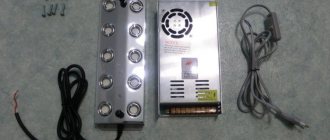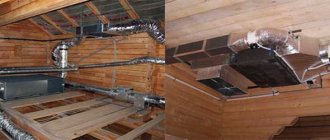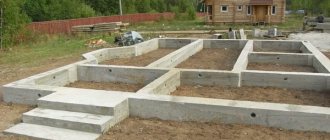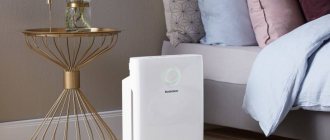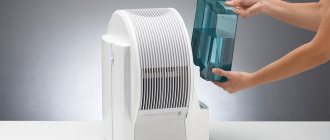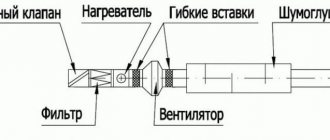Air parameters in the premises of a house are an important component of the well-being of the people living in it. But many people pay attention to temperature, although there is one more indicator that should not be forgotten. This is normal air humidity. Let's figure out what humidity should be in the house, what it affects, how to measure and change.
Optimal humidity value in the house Source navseruki.guru
High or low humidity - what are the problems?
If we talk about humidity as a physical quantity, then this is the amount of water vapor present in a unit volume of a room. Usually 1 m³. It is clear that the volume of a room is the volume of air. That's why they talk about air humidity.
Scientists have divided this parameter into two types:
- Absolute humidity . This is the amount of water in a cubic meter of air mass.
- Humidity is relative . This is the ratio of the absolute value to the maximum possible moisture concentration inside the air at a given temperature. And this ratio of the two indicators is multiplied by 100.
So, when they talk about indoor air humidity - the norm, they mean a relative variety. It is the norm that determines the quality of living of people, the normal growth of house plants, as well as the long-term operation of household appliances, furniture and other household utensils. A large deviation from the norm in one direction or the other reduces the above-mentioned living conditions.
Absolute and relative humidity in the room Source tildacdn.com
For example, how dry air can affect a person:
- human moisture loss through the skin increases;
- accordingly, the elasticity of the skin, hair and nails decreases, and accordingly wrinkles appear, nails split, hair splits;
- the mucous membrane of the eyes dries out, causing symptoms such as “sand” in the eyes, itching, redness;
- the loss of water in the human body, or rather in the blood, leads to its thickening, hence headaches, heart rate increases, blood pressure increases, performance decreases, and weakness appears;
- digestion also slows down because the concentration of fluid inside the gastrointestinal tract decreases, which often leads to constipation;
- immunity decreases due to drying of the mucous membranes of the respiratory tract, which often leads to ARVI;
- The concentration of respiratory allergens in the air increases because they are bound by droplets of moisture if the indoor air humidity is normal.
Dry air is the cause of allergens Source chitazdrav.ru
As you can see, there are many problems with dry air in rooms. But this does not mean that increased humidity will create favorable living conditions. This also has its own problems, which are mainly associated with the appearance of microorganisms such as mold and fungi in the premises. Why are they dangerous:
- residents of such houses suffer from chronic respiratory diseases: allergies, runny nose, bronchitis, asthma;
- there is always a feeling of discomfort, especially humidity and stuffiness;
- the proliferation of microorganisms causes an unpleasant odor;
- Furniture deteriorates, washed clothes take a long time to dry, etc.
What happens from dry air.
When the cold season sets in and the heating is turned on in the apartments, the air begins to dry out. Due to lack of moisture, the body loses resistance. Dry mucous membranes no longer prevent viruses and bacteria, become thinner and allow them to pass through. Static electricity spreads germs and dust mites, causing allergies. The appearance also suffers from dry hair and skin.
Effects of dry air:
- Dried and lifeless hair, dry and thin skin. The result is split ends, wrinkles and cracks in the skin. Dermatitis worsens and resistance to infections is lost.
- Feeling of dry eyes, irritation. Feeling of the presence of sand or a foreign object. The strain on the eyes increases and due to fatigue, dry eye syndrome occurs.
- Slowing down digestion. This occurs from an increase in the viscosity of intestinal and gastric juices.
- In an environment with dry air, respiratory allergens actively multiply. This is contraindicated for people with allergies, and especially asthma.
- Dizziness, headaches, general weakness and increased stress on the heart. These are consequences of blood thickening and slowing of its circulation.
- Dried mucous membranes begin to let more viruses through, and people suffer from respiratory infections more often. The thinning of the protective membrane causes nosebleeds.
Important to know Indoor plants and pets suffer from the lack of sufficient air humidification. The wear life of natural wood furniture is reduced
What affects humidity
In general, with humidity, or rather with the factors influencing it, the situation is paradoxical. Firstly, it completely depends on the air temperature. Purely according to physical laws, the higher the temperature, the more water can fit into the air. Because it increases in volume under the influence of rising temperatures.
What affects humidity Source 900igr.net
And everything would be so if the conversation was about an absolute indicator. And since we are talking about humidity inside the house, here, as mentioned above, the relative parameter is taken into account. And in this case, physical laws operate in reverse. That is, the higher the air temperature, the lower its humidity will be. This means relative. Because the volume of air has increased, but the amount of water in it has not changed.
What household appliances and objects affect relative humidity:
- heating devices: heating radiators, fireplaces, stoves and others;
- air conditioners;
- carpets, upholstered furniture, soft toys, curtains and more.
But the following devices lead to increased humidity inside the house:
- aquarium;
- leaking pipes;
- boiling kettles and pots;
- the roof, if it leaks somewhere;
- wet laundry hanging inside the house.
An aquarium in a house increases humidity Source yandex.net
See also: Catalog of companies that specialize in complex installation of internal engineering systems of a country house.
Choosing a Humidifier/Dehumidifier
Although a dehumidifier and a humidifier are completely different devices, the principles for choosing the optimal model for them are the same. Pay attention to:
- Performance. This determines whether the device can cope with the available air volume in the room.
- Water tank capacity. The larger the container, the longer the device can operate from one refill (humidifier) or until the container is filled with water (dryer).
- Noise level. Particularly relevant for bedrooms and children's rooms.
- Power consumption. Economical and not so efficient devices are produced.
- The presence of a built-in hygrometer and the ability to set the required humidity level.
- Dimensions, weight, design. The device should fit well into the interior.
- Availability of timer, backlight and other additional functions.
- Availability of washable filters and other useful options.
Standards
Let's now figure out what humidity should be in the room. Everything will, of course, depend on the purpose of the room and the time of year. But there are regulations where normal humidity is indicated by certain values.
Eg:
- In the warm season, this figure varies in the range of 30-60%. There is such a thing as the maximum permissible norm. It is equal to 65%. In some regions, for example, maritime regions, 75% is considered the norm.
- In cold weather, the norm is 30-45%, the maximum is 60%.
Note! These indicators are only for residential premises and specifically for humans. In rooms such as corridors, hallways, toilets and bathrooms, and storage rooms, humidity is not standardized.
Also, do not forget that there are plants, furniture, household appliances, etc. in the house. For them, the standards are slightly different from the above:
- For plants – 40-70%, for tropical – 80-95%, for subtropical – 75-80%.
- Books are best stored at a humidity of 30-65%.
- Furniture and paintings are well preserved at 40-60%.
- The same goes for antiques.
- For technology, 45-60% is suitable.
Optimal humidity in the house Source ventilation-conditioning.ru
So, the optimal humidity in a room for a person is from 30 to 60%. But if children live in the house, then the standard in their rooms is slightly different. Here this figure should be in the range of 50-70%. Because children are more sensitive to various harmful bacteria, infections and other parasites. Plus, they have a higher intensity of heat exchange processes in the body. That is, they release moisture faster, due to which the fluid content in the body decreases. Therefore, doctors recommend that sick children stay in rooms where the humidity does not drop below 60%.
Attention! In the winter season, when the heating system is turned on in houses, the moisture content inside the rooms decreases sharply - by 15-20%. Therefore, if your family has children, as well as asthmatics and allergy sufferers, then this air parameter must be maintained artificially.
Heating appliances greatly reduce indoor humidity Source naimtruda.com
What needs to be done to make the air in the apartment optimal.
The temperature of the room has a great influence on the feeling of humidity. The warmer the air, the more water it absorbs. When calculating relative humidity, do not forget that in the presence of high temperatures, the volumes of liquids in these quantities of air will become smaller. Knowing this allows you to maintain normal humidity levels by ventilating the room in winter. In this way you can achieve optimal parameters.
Absorbs moisture:
- heating elements;
- soft toys, furniture, rugs, carpets;
- air conditioners.
Sources of moisture:
- aquariums;
- house plants;
- wet tissues;
- water boiling when cooking food;
- leaking and faulty plumbing.
Rules for measuring relative humidity
Having decided on the norm of humidity in the room, we will understand the methods for measuring it. The easiest and most accurate way is to use a hygrometer. In stores, this device is presented in a wide variety. And they differ from each other in the measurement method and operating principle. Namely:
- electrical;
- condensation;
- hair;
- chemical and others.
Psychrometric hygrometer, also known as psychrometer Source 900igr.net
Video description
In the video, a specialist talks about psychrometers and how they can be used to measure indoor air humidity:
There are other measurement options that can be classified as “folk”. The easiest one here is to use a glass of water. It is pre-cooled to +5 °C, for example, it can be placed in the refrigerator for several hours. And then they are placed in a room away from heating devices.
If the outer surfaces of the glass dry quickly, say in a few minutes, then the humidity in the room is greatly reduced. If there is evaporation left on them and it does not disappear, the humidity in the room is normal. If streams of water flow down the walls of the glass, then most likely the humidity in the room is high.
Foggy glass of cold water Source onegoodthingbyjillee.com
Protection of house structures from moisture
Even at the construction stage, it is necessary to ensure that the house is located on dry ground. Proper equipment of the building with a drainage system, regular checking of the condition of drains and gutters will guarantee the free and rapid outflow of water during rain, and will prevent the accumulation of moisture near the foundation.
A successful location of a residential building, proper operation of the drainage and water outflow system will ensure quick drying of wall panels and house structures. In order to increase the moisture resistance of laminated timber, it is best to treat the outer surfaces with moisture-proof compounds. Typically, these components are included in current paint and varnish materials, so painting the outside of a house will not only serve an aesthetic function, but also provide protection to house structures from moisture. Otherwise, the external elements of the structure will quickly darken, which will become an excuse for subsequent sanding of the laminated veneer lumber.
Translucent water-based paints not only preserve the structure and appearance of wooden structures, but also additionally increase the moisture resistance of laminated veneer lumber. Accordingly, treated structures are less susceptible to rotting, and there is less likelihood of mold and mildew forming in hard-to-reach places.
How can you regulate humidity?
You need to choose methods of change depending on whether this parameter is high or low. Let's start with the first one, that is, high humidity. What can you offer:
- organize frequent ventilation;
- install dehumidifiers;
- install hoods;
- constantly monitor plumbing and heating, water supply and sewerage pipes so that they are in sealed and in good condition;
- use different types of heaters to heat the house;
- Do not dry laundry inside.
Now about how you can increase relative humidity:
- install an aquarium or a decorative fountain in one of the rooms;
- use air conditioners and heaters as little as possible;
- install sprinklers, also known as humidifiers, or do it with a hand sprayer;
- carry out wet cleaning more often;
- place wet towels on heating radiators;
- plant as many house plants as possible.
Enemies of air humidity
So, having dealt with the question of what humidity should be in a living room, we move on to household appliances, which greatly underestimate this parameter. Let's start with the fact that all electrical appliances heat up and produce heat. And accordingly, they heat the air temperature inside the house, reducing humidity.
Of particular note is the air conditioning, which everyone uses in the summer. Its operating principle is based on the fact that the device takes in humidity, condensing it on a heat exchanger located in the indoor unit. And this water is carried out into the street through a tray and a hose.
Here you need to add TVs, computers and other electrical appliances. But the most serious enemy of the humidity regime is the heating system of the house. In winter it can reduce this parameter to 20%, which is already considered a critical value.
Many people try to solve this problem by ventilation. But not many people know that there is little moisture in cold air. And if you let it into the room, it heats up, expands and becomes dry.
Tips for normalizing the microclimate
To maintain the proper microclimate in the apartment, you can use the recommendations of specialists.
So, to combat excessively dry air, the following are used:
- traditional methods;
- special devices.
A decorative fountain, a spacious aquarium with colorful fish or flowerpots with house flowers are not only spectacular interior decorations, but also an effective way to maintain normal humidity in the atmosphere of a living space, for example, a living room.
An elementary effective way to increase the content of water vapor is regular wet cleaning and ventilation of the room. They guarantee the maintenance of an optimal indoor microclimate
A simple but quite effective remedy is to place containers of water near heating appliances or on radiators. Liquid must be added to the vessels as it evaporates.
Alternatively, wet towels, napkins or other pieces of fabric are thrown over the batteries. You can also hang washed clothes in the room to dry.
An alternative to a complex device can be a simple device made from a plastic bottle and a bandage (+)
Special humidifying devices, the operation of which is based on various methods, will help to radically solve the problem with the level of humidity:
- mechanical humidifier with a fan, quite noisy, but not very effective - 50-61%;
- steam humidifier , functioning similarly to an electric kettle. It is capable of increasing the vapor content rate by 60%;
- ultrasonic humidifier , the method of operation of which is based on spraying water droplets using a piezoelectric emitter. The device, which quickly increases humidity to 100%, is characterized by silent and safe operation.
The first two options are distinguished by their affordable cost and the ability to use tap water, while the more expensive ultrasonic device requires distilled liquid to operate.
To reduce the degree of air humidity, you can also use either traditional methods or resort to the help of modern devices.
In a damp room, care should be taken to let in as much sunlight as possible. There is no need to shade the windows with curtains, because the rays of the sun perfectly dry the air. Housing should be regularly ventilated to bring in fresh air.
There are various models of dehumidifiers. These household appliances are capable of removing from 12 to 50 liters of moisture daily
Forced exhaust ventilation can be installed in all rooms, and in the kitchen it is better to cook with a powerful hood on. If an air conditioner is installed in the apartment, it is important to choose the optimal operating mode.
If the air temperature is insufficient, you should think about using additional heating devices. When carrying out construction and finishing work, it is advisable to prefer natural materials that absorb moisture well.
The best results can be achieved using special devices.
Two categories of devices are most often used:
- plastic containers filled with adsorbents - substances that actively absorb water vapor; it is important not to forget to change the filler as it gets wet;
- household dehumidifiers , the operation of which is usually based on the principle of condensation of atmospheric water vapor on a plate whose temperature is below the dew point.
To normalize the indoor microclimate, it is important to pay attention to windows and window treatments. It is best to install modern double-glazed windows made using new technologies that guarantee air circulation.
Interesting Facts
It is a well-known fact that fog means one hundred percent humidity. But this natural phenomenon is possible only at a temperature of 0 °C. If the fog is placed in a room with a temperature of +22 °C, then the humidity in such a room will become only 23%. This shows well how temperature changes humidity.
Dry air seems colder to us. And vice versa. It's all about our body, which produces sweat in hot weather. The latter is moisture, which performs the functions of thermoregulation of the body. That is, sweat makes our skin moist, thereby removing heat from its surface. The same thing happens in winter. Only in this case does dry air cool the skin. Therefore, this air seems colder to us.
Please note that an increase in temperature of just 2 °C entails a decrease in humidity by 25%. Therefore, you should not heat your home too much. Room temperature, namely +18-22 °C, is the optimal mode in which the humidity is also in ideal condition. That is, by adhering to these two parameters, you can save a lot of money on heating your home in winter.
How does a person feel at different air humidity Source v.5klass.net
Briefly about the main thing
The optimal air humidity in residential premises is 30-60%. In children's rooms it is better to keep it at 70%. This also applies to rooms where asthmatics and allergy sufferers live.
The simplest device that measures indoor humidity is a psychrometric hygrometer, also known as a psychrometer.
It is useless to ventilate rooms in winter to increase humidity. Because there is little moisture in cold air. Once inside the house, it heats up, becoming dry, which helps reduce the humidity level.
The biggest enemy of humidity is the heating system of the house. But this indicator is also affected by all electrical household appliances.
To increase this indicator, it is recommended to install household humidifiers; fortunately, they are presented in a huge assortment in stores.
Optimal temperature
The optimal temperature in residential premises, as well as humidity, is established by the interstate standard GOST R 51617–2000. According to this document, the temperature in the bedroom, living room and corridor should fluctuate between 20°C and 22°C. The upper threshold for a living room is 24°C. In the bathroom, GOST sets the standard at 25°C, in the toilet - 18°C, as well as in utility rooms (pantry, drying room). For the kitchen the value is set at 19–21°C.
Air temperature is an important component of the microclimate of an apartment
In the hot season, the temperature in the apartment should rise by 1–2°C, no more. The maximum permissible room temperature in summer is 25°C.
Temperature in the nursery
The microclimate in a children's room is somewhat different from ordinary living quarters, because a child, being active and mobile, needs a cooler environment. Moreover, the temperature in the nursery greatly depends on the age of the child. So, the baby needs warmer air - 23–24°C. Children from three years old feel more comfortable in cool temperatures - 18–19°C. Then, as the child grows up, the temperature is adjusted to the “adult” value of 20–22°C.
Correctly set temperature in the children's room is the key to good health and good sleep for the child.
An excessively high temperature in the nursery forces the child’s body to regulate its heat exchange using sweat glands. As a result, the baby becomes sweaty, and diaper rash and redness may form. Moreover, losing a significant amount of moisture through sweat, the child begins to suffer from dehydration - this leads to pain, problems with digestion of food, as well as diseases of the oral cavity caused by insufficient saliva production.
Bedroom temperature
The air in the bedroom should not be too warm - no more than 21°C, ideally 19°C. You've probably noticed that it's almost impossible to fall asleep in a hot room. Because of this, many people ventilate their bedrooms before bed—temporarily lowering the temperature to help them drift off more peacefully. Unfortunately, from the point of view of microclimate regulation, this measure is not entirely correct.
Cool air in the bedroom helps you sleep more soundly
The coolness in the bedroom must be maintained not only at the moment of falling asleep, but also throughout the entire duration of sleep, so simply ventilating the room is not enough. Of course, it never hurts to freshen the air before bed, but if late at night the temperature in the bedroom rises again to 22–24 ° C, sleep will be restless, and in the morning you will wake up completely exhausted.
Another reason to keep your bedroom temperature lower is to look good. In a cool environment, our body releases melatonin better during sleep. This substance helps fight aging, smooths out age-related wrinkles and improves the color and tone of the facial skin.
Cool air in the bedroom helps maintain youthful skin
Kitchen temperature
The microclimate of the kitchen greatly depends on the appliances installed in it and the intensity of their use. The optimal temperature in this room is 19°C, but often there is no need to regularly maintain this temperature.
The temperature in the kitchen can vary greatly depending on the use of different appliances
The main device that affects the temperature in the kitchen is the stove. A gas burner emits more heat into the air, and therefore in a kitchen equipped with it it is worth lowering the temperature by 1 degree - the lack of heat is compensated by cooking over a fire. Active use of the oven also significantly insulates the room.
If household members hardly use a stove or oven, preferring an electric steamer or multicooker, it is worth, on the contrary, raising the temperature to 20°C - such appliances emit little heat and do not warm the air in the room.
The multicooker, beloved by many housewives, has low heat transfer
Bathroom temperature
The temperature in the bathroom should not be lower than 23°C, optimally 25°C. This high rate is due to two simple reasons. Firstly, high humidity at low temperatures creates a feeling of chilly cold and unpleasant dampness, and secondly, wet skin feels the temperature even lower than it actually is.
The bathroom should be kept at a higher temperature than living rooms
To prevent mold from growing due to the combination of heat and humidity, be sure to ventilate the bathroom after taking a shower or other water procedures. Leave the door open for at least half an hour - this prevention is usually enough to prevent the development of fungus on the walls.
Deviations from the norm
Reducing the air temperature in the apartment below the specified standards entails negative consequences:
- Risk of colds. Hypothermia very often causes unpleasant symptoms such as chills, runny nose, and sore throat.
- Reduced humidity. Cold air has less humidity than warm air.
- Constant tension in the body. If our body is not warm enough, it tends to expend energy and warm itself up. This, accordingly, reduces immunity and energy - constantly spending energy on warming up, we leave ourselves little energy for active movements.
If the room is warmer than specified in the standards, this leads to the following consequences:
- Peeling of the skin. In young children it may also manifest itself in the form of dermatitis. Due to the presence of microcracks, pathogenic bacteria easily penetrate into the skin, causing inflammation.
- Drying of the mucous membrane. Warm air, even well-humidified, does not provide our mucous membranes with sufficient moisture. If you regularly breathe such air, you can dry out your nasopharynx, which will result in a sore throat and vulnerability to pathogenic bacteria and viruses.
- Digestive problems. Warm air also affects the condition of the gastrointestinal mucosa. Without producing enough mucus, our body cannot maintain proper digestion. This can cause abdominal pain and colic in young children.
- Risk of hypothermia. Oddly enough, increased temperature in the apartment can cause hypothermia. In a hot environment, our sweat glands begin to actively work, trying to cool us down. If at this time we go, for example, outside, where it is not so warm, we can easily become hypothermic and catch a cold.

